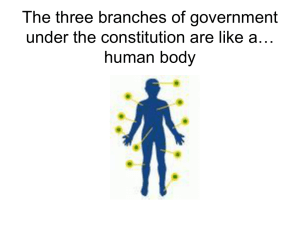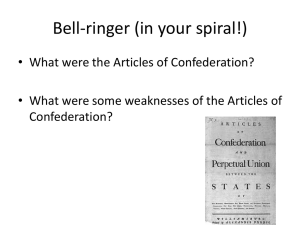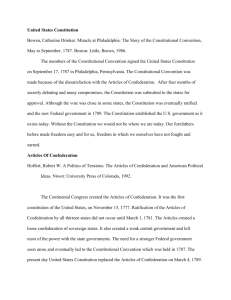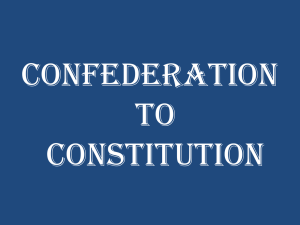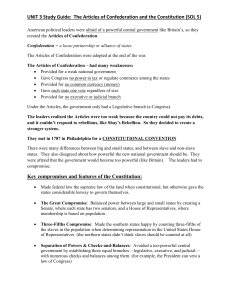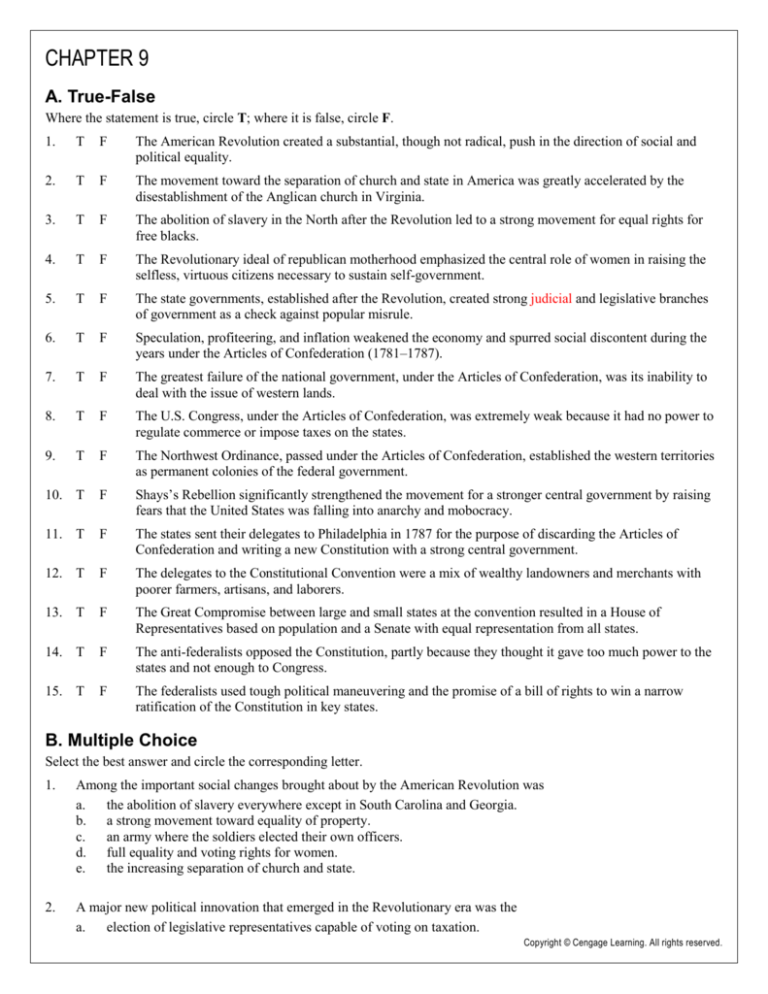
CHAPTER 9
A. True-False
Where the statement is true, circle T; where it is false, circle F.
1.
T
F
The American Revolution created a substantial, though not radical, push in the direction of social and
political equality.
2.
T
F
The movement toward the separation of church and state in America was greatly accelerated by the
disestablishment of the Anglican church in Virginia.
3.
T
F
The abolition of slavery in the North after the Revolution led to a strong movement for equal rights for
free blacks.
4.
T
F
The Revolutionary ideal of republican motherhood emphasized the central role of women in raising the
selfless, virtuous citizens necessary to sustain self-government.
5.
T
F
The state governments, established after the Revolution, created strong judicial and legislative branches
of government as a check against popular misrule.
6.
T
F
Speculation, profiteering, and inflation weakened the economy and spurred social discontent during the
years under the Articles of Confederation (1781–1787).
7.
T
F
The greatest failure of the national government, under the Articles of Confederation, was its inability to
deal with the issue of western lands.
8.
T
F
The U.S. Congress, under the Articles of Confederation, was extremely weak because it had no power to
regulate commerce or impose taxes on the states.
9.
T
F
The Northwest Ordinance, passed under the Articles of Confederation, established the western territories
as permanent colonies of the federal government.
10. T
F
Shays’s Rebellion significantly strengthened the movement for a stronger central government by raising
fears that the United States was falling into anarchy and mobocracy.
11. T
F
The states sent their delegates to Philadelphia in 1787 for the purpose of discarding the Articles of
Confederation and writing a new Constitution with a strong central government.
12. T
F
The delegates to the Constitutional Convention were a mix of wealthy landowners and merchants with
poorer farmers, artisans, and laborers.
13. T
F
The Great Compromise between large and small states at the convention resulted in a House of
Representatives based on population and a Senate with equal representation from all states.
14. T
F
The anti-federalists opposed the Constitution, partly because they thought it gave too much power to the
states and not enough to Congress.
15. T
F
The federalists used tough political maneuvering and the promise of a bill of rights to win a narrow
ratification of the Constitution in key states.
B. Multiple Choice
Select the best answer and circle the corresponding letter.
1.
Among the important social changes brought about by the American Revolution was
a.
the abolition of slavery everywhere except in South Carolina and Georgia.
b. a strong movement toward equality of property.
c.
an army where the soldiers elected their own officers.
d. full equality and voting rights for women.
e.
the increasing separation of church and state.
2.
A major new political innovation that emerged in the Revolutionary era was the
a.
election of legislative representatives capable of voting on taxation.
Copyright © Cengage Learning. All rights reserved.
Chapter 9: The Confederation and the Constitution, 1776–1790
b.
c.
d.
e.
81
shifting of power from the legislative to the executive branch of government.
idea of a written constitution drafted by a convention and ratified by direct vote of the people.
extension of voting rights to indentured servants.
direct election of judges by the people.
3.
Despite the Revolution’s emphasis on human rights and equality, the Founding Fathers failed to abolish slavery
because
a.
they saw it as necessary to maintain American power.
b. they feared black rebellion if slavery were removed.
c.
of their fear that a fight over slavery would destroy fragile national unity.
d. almost none of them believed that slavery was wrong.
e.
many of them felt guilty about interracial sexual liaisons with their slaves.
4.
The ideal of republican motherhood that emerged from the American Revolution held that
a.
women should be rewarded politically for having helped establish the American republic.
b. women had a special responsibility to cultivate the civic virtues of republicanism in their children.
c.
the government should establish social services to help mothers raise their children.
d. mothers should be granted full political and economic rights in the American republic.
e.
mothers had a responsibility to teach principles of equality to their daughters as well as sons.
5.
The fundamental difference between ordinary laws and a constitution that emerged from the American Revolution
was that ordinary laws
a.
described specific illegal acts, while a constitution granted positive rights.
b. addressed economic questions, while a constitution addressed the distribution of political power.
c.
could be passed and repealed by legislatures, while a constitution was a fundamental law ratified by the people
and superior to all legislation.
d. applied to the states; a constitution was a document of the federal government.
e.
were approved by the people, while a constitution emerged from the decisions of judges.
6.
One way that American independence actually harmed the nation’s economic fortunes was by
a.
ending British trade and investment in America.
b. abolishing the stable currency system that had existed under the empire.
c.
creating too much taxation and regulation by the federal government in Philadelphia.
d. weakening the manufacturing efforts begun under the British.
e.
cutting off American trade with the British empire.
7.
Attempts to establish strong governments in post-Revolutionary America were seriously hindered by the
a.
lack of strong leadership available in the new nation.
b. revolutionary ideology that preached natural rights and suspicion of all governmental authority.
c.
hostility of the clergy toward the idea of separation of church and state.
d. fear that a strong government would suppress economic development.
e.
seizure of power by dangerous demagogues like Daniel Shays.
8.
The first U.S. government of the Articles of Confederation was finally approved when
a.
George Washington insisted that he needed a single ruling authority to deal with.
b. land-rich states like Virginia and New York agreed to hand over their lands to the new government for the
common benefit.
c.
Congress abandoned the principle that each state had one vote regardless of size.
d. the economy was plunged into severe depression that required drastic action.
e.
Britain refused to honor the Peace of Paris by holding onto its forts in the West.
Copyright © Cengage Learning. All rights reserved.
82
9.
Chapter 9: The Confederation and the Constitution, 1776–1790
The greatest weakness of the government under the Articles of Confederation was that
a.
it was unable to deal with the issue of western lands.
b. it was still too subservient to America’s ally, France.
c.
it had no power to establish relations with foreign governments.
d. there was no judicial branch to balance the legislative and executive branches.
e.
it had no power to regulate commerce or collect taxes from the sovereign states.
10. The Northwest Ordinance of 1787 provided that
a.
the states should retain permanent control of their western lands.
b. money from the sale of western lands should be used to promote manufacturing.
c.
after sufficient population growth, western territories could be organized and then join the union as states.
d. the settlers in the northwest could vote on whether or not they should have slavery.
e.
the Old Northwest states should have permanent access to the Great Lakes water.
11. Shays’s Rebellion contributed greatly to the movement for a new constitution by
a.
revealing that Revolutionary War veterans like Shays wanted a more powerful federal government.
b. raising the fear of anarchy and disorder among wealthy conservatives.
c.
raising the prospect of British or French interference in American domestic affairs.
d. showing that state legislatures could effectively resist the demands of radical farmers.
e.
proving that America needed a stronger military to crush domestic rebellions.
12. Besides George Washington, the most influential delegates to the Constitutional Convention were
a.
John Jay, Thomas Jefferson, and John Hancock.
b. Samuel Adams, Patrick Henry, and Thomas Paine.
c.
John Adams, Abigail Adams, and Gouverneur Morris.
d. Benjamin Franklin, James Madison, and Alexander Hamilton.
e.
Daniel Shays, Richard Henry Lee, and John Marshall.
13. The Great Compromise, finally agreed to by the Constitutional Convention, provided that
a.
the House of Representatives would be elected by the people and the Senate by the state legislatures.
b. the large states would be taxed on the basis of population and the small states on the basis of territory.
c.
there would be separation of powers between the executive and legislative branches of government.
d. there would be representation by population in the House of Representatives but equal representation of all
states in the Senate.
e.
slavery would continue to be permitted in the South but not in the North.
14. Antifederalists generally found their greatest support among
a.
residents of small states like Delaware and New Jersey.
b. the commercial areas of the eastern seaboard.
c.
former Loyalists and others who disliked American Revolutionary ideals.
d. the wealthy and well educated.
e.
the poorer debtors and farmers.
15. The crucial federalist successes in the fight for ratification occurred in the states of
a.
Georgia, Maryland, and Delaware.
b. Massachusetts, Virginia, and New York.
c.
Pennsylvania, North Carolina, and Rhode Island.
d. Connecticut, South Carolina, and New Hampshire.
e.
Kentucky, Tennessee, and Vermont.
Copyright © Cengage Learning. All rights reserved.
Chapter 9: The Confederation and the Constitution, 1776–1790
83
C. Identification
Supply the correct identification for each numbered description.
1.
___________________
Virginia and elsewhere
New name for the Anglican Church after it was disestablished and de-Anglicized in
2.
___________________
their children
The idea that American women had a special responsibility to cultivate civic virtue in
3.
___________________A type of special assembly, originally developed in Massachusetts, for drawing up a
fundamental law that would be superior to ordinary law
4.
___________________ The first constitutional government of the United States
5.
___________________ The territory north of the Ohio River and east of the Mississippi River that came to be
governed by the Confederation’s acts of 1785 and 1787
6.
___________________ In the new Northwest territories, six-mile by six-mile square areas consisting
of thirty-six sections, one of which was set aside for public schools
7.
___________________ The status of a western area under the Northwest Ordinance after it established an organized
government but before it became a state
8.
___________________ A failed revolt in 1786 by poor debtor farmers that raised fears of mobocracy
9.
___________________The large-state plan proposed to the Constitutional Convention by which representation both
houses of the federal legislature would be based on population
10. ___________________The small-state plan proposed to the Constitutional Convention by which every state would
have completely equal representation in a unicameral legislature
11.
___________________The Constitutional compromise between North and South that resulted in each slave being
counted as 60 percent of a free person for purposes of representation in Congress
12. ___________________The opponents of the Constitution who argued against creating such a strong central
government
13. ___________________
Hamilton
A masterly series of pro-Constitution articles printed in New York by Jay, Madison, and
14. ___________________The official under the new Constitution who would be commander-in-chief of the armed
forces, appoint judges and other officials, and have the power to veto legislation
15. ___________________A list of guarantees that federalists promised to add to the Constitution in order to win
ratification
Copyright © Cengage Learning. All rights reserved.
84
Chapter 9: The Confederation and the Constitution, 1776–1790
D. Matching People, Places, and Events
Match the person, place, or event in the left column with the proper description in the right column by inserting the correct
letter on the blank line.
1.
Society of the Cincinnati
a.
2.
Virginia Statute for Religious
Freedom
Group that failed to block the central government they
feared but did force the promise of a bill of rights
b.
Father of the Constitution and author of Federalist No.
10
c.
An exclusive order of military officers that aroused
strong democratic opposition
d.
Wealthy conservatives devoted to republicanism who
engineered a nonviolent political transformation
e.
Legislation passed by an alliance of Jefferson and the
Baptists that disestablished the Anglican church
f.
Revolutionary War veteran who led poor farmers in a
revolt that failed but had far-reaching consequences
g.
Revered elder statesman whose prestige in the
Constitutional Convention helped facilitate the Great
Compromise
h.
Brilliant book of essays by Madison, Hamilton, and Jay
that helped sway critical support for the Constitution in
New York
i.
Frustrated foreign affairs secretary under the Articles;
one of the three authors of The Federalist
j.
Legislation that provided for the orderly transformation
of western territories into states
k.
Leading Massachusetts radical during the American
Revolution who led the opposition to the Constitution in
his state in 1787
l.
Virginia antifederalist leader who thought the
Constitution spelled the end of liberty and equality
m.
Unanimously elected chairman of the secret convention
of demi-gods
n.
Young New Yorker who argued eloquently for the
Constitution even though he favored an even stronger
central government
o.
Original American governmental charter of 1781 that was
put out of business by the Constitution
3.
Articles of Confederation
4.
Northwest Ordinance of 1787
5.
Benjamin Franklin
6.
Daniel Shays
7.
George Washington
8.
James Madison
9.
federalists
10.
antifederalists
11.
Patrick Henry
12.
Alexander Hamilton
13.
John Jay
14.
Samuel Adams
15.
The Federalist
Copyright © Cengage Learning. All rights reserved.
Chapter 9: The Confederation and the Constitution, 1776–1790
85
E. Putting Things in Order
Put the following events in correct order by numbering them from 1 to 5.
1.
________ Fifty-five demi-gods meet secretly in Philadelphia to draft a new charter of government.
2.
________ The first American national government, more a league of states than a real government, goes into effect.
3.
________ At the request of Congress, the states draft new constitutions based on the authority of the people.
4.
________ The Constitution is ratified by the nine states necessary to put it into effect.
5.
________ Debtor farmers fail in a rebellion, setting off conservative fears and demands for a stronger government to
control anarchy.
F. Matching Cause and Effect
Match the historical cause in the left column with the proper effect in the right column by writing the correct letter on the
blank line.
Cause
1.
__
The American Revolution
2.
__
Agreement among states to give up
western land claims
3.
__
The weakness of the Articles of
Confederation
4.
__
Shays’s Rebellion
5.
__
The conflict in the Constitutional
Convention between large and small
states
6.
__
The North-South conflict in the
Constitutional Convention over
counting slaves for representation
7.
8.
9.
__
__
__
10. __
Effect
a.
Forced acceptance of the Three-Fifths Compromise,
counting each slave as three-fifths of a person for
purposes of representation
b.
Made the federalists promise to add a bill of rights to
the Constitution
c.
Nearly bankrupted the national government and invited
assaults on American interests by foreign powers
d.
Laid the basis for the Virginia Statute for Religious
Freedom and the separation of church and state
e.
Brought about somewhat greater social and economic
equality and the virtual end of slavery in the North
f.
A meeting in Annapolis to discuss
revising the Articles of Confederation
Finally brought New York to ratify the Constitution by
a narrow margin
g.
Antifederalist fears that the
Constitution would destroy liberties
Issued a call to Congress for a special convention to
revise the Articles of Confederation
h.
Forced the adoption of the Great Compromise, which
required a bicameral legislature with two different
bases of representation
i.
Scared conservatives and made them determined to
strengthen the central government against debtors
j.
Made possible the approval of the Articles of
Confederation and the passage of two important laws
governing western lands.
The Federalist and fears that New
York would be left out of the Union
The disestablishment of the Anglican
Church
Copyright © Cengage Learning. All rights reserved.

